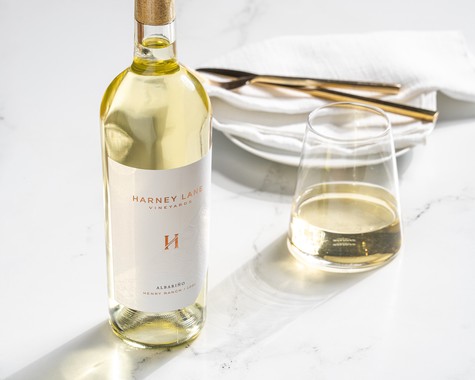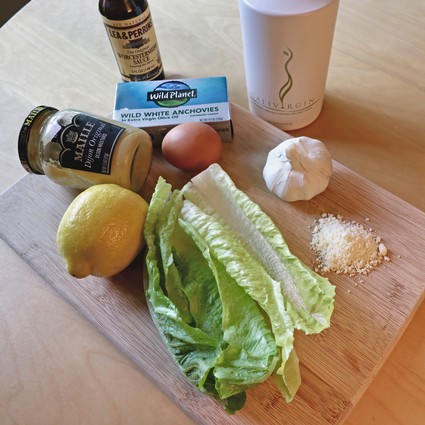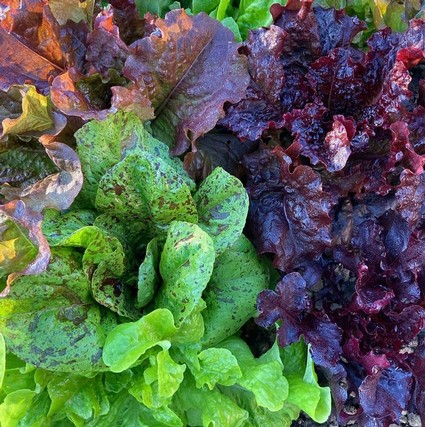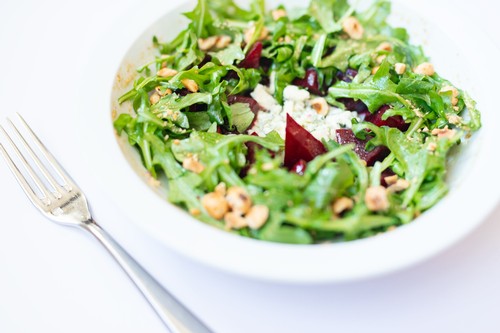Letters from Lodi
An insightful and objective look at viticulture and winemaking from the Lodi
Appellation and the growers and vintners behind these crafts. Told from the
perspective of multi-award winning wine journalist, Randy Caparoso.
In summer the living is easier with fresh salads washed down with contemporary style Lodi wines

Lorenza Wine's Melinda Kearney (middle) hosting a light summer lunch with her contemporary style, acid-driven red wines made from Cinsaut and Carignan.
It's summer. Perfect time to talk about... salads!
When the weather gets hot, the body almost craves this healthy alternative to heavy, starchy meals. Salad lovers know that if you get crafty⏤like utilizing crisped bits of bacon, slivers of salmon, smoked tuna or crabmeat, and slices of cheese like feta and mozzarella⏤you are essentially creating an entire meal in itself.
If, of course, your spouse or kids complain, you can always fry tiny cuts of beef or pork to meet their carnivorous demands. Summer is like that. Instead of a big steak with a little side of salad, you have a big salad with a tiny side of meat. And besides, if you cut out potatoes, bread, or rice, summertime salads are an ideal way of keeping weight or blood sugar down.

Quintessential contemporary style white wine: Lodi Albariño grown and produced by Harney Lane Winery. Harney Lane Winery.
Salads are also, in case you haven't discovered this yourself, wonderful with wines. Not all wines. Because of the way salads are made, almost always tossed in tart vinaigrettes (my family often dispenses with olive oil altogether and just drizzles on balsamic or wine vinegar at the table), they are more ideal with the styles of wine I would describe as "contemporary."
That is to say, wines that are a little different than, perhaps, most of the wines you find on store shelves, which are made to taste very soft and smooth yet filling in the body (i.e., alcohol), which is what the commercial wine industry generally perceives as what the "American palate" mostly wants. The wines I call contemporary are different in the following ways:
• They tend to have a perceptible amount of acidity or tartness.
• They are a little lighter in alcohol (closer to 11% or 12% ABV).
• Their aromas typically suggest tart qualities, such as citrus fruits (the full range, from lemon to orange), sour cherry, and sometimes even pomegranate or rhubarb.

Vine-ripened tomatoes at Lodi Farmers Market.
Therein lies the reason why these styles of wine, more than others, often taste wonderful with salads: They balance out the tartness of salads.
The make-up of salads, of course, tends to be as wonderfully varied as anyone's imagination and predilections. It may be incessant cravings for olives or mushrooms, parmesan or mozzarella, tomatoes or bitter greens, artichokes or beans—everyone is different, and everyone has the preferences that they want to see in salads.

Bokisch Vineyards' Markus and Liz Bokisch, pioneered Lodi Albariño farming and production, starting in the late 1990s.
To get you to think a little bit about what might be the ideal wines fitting into your particular spectrum of particularities, let's discuss wines to go with some salads typically found in local Lodi restaurants and the reasons why certain wines may go better with them than others:
Caesar Salad
Recommended wines: Light, zesty reds
Caesar salads are everywhere; although, as you know, not all restaurant versions are exactly alike. Let's just say that almost all of them are variations of the original style of Caesar which...
• Is made with romaine, a crunchy yet mild-tasting lettuce green.
• Does not get its tart taste from vinegar, but rather from the zesty taste of fresh lemon.
• Utilizes a lot of high umami flavors⏤that is, food components consisting of stronger amounts of glutamates, which give foods their savory taste (like in packaged snack foods you can't stop eating)⏤found in the key ingredients of most Caesars, such as parmesan, anchovy (even the smallest amount goes a long way in a Caesar), garlic, Dijon mustard, and Worcestershire sauce.

The savory/tart ingredients used to make Caesar salad, add up to a dish best enjoyed with light, acid-driven red wines.
The taste of a Caesar, in other words, is skewed mostly towards umami and tartness, and less towards, say, olive oil (oil plays such a small part in a typical Caesar, the original recipes called for plain, bland vegetable oil).
Because of its fresh lemon component, Caesar salad tastes perfectly good with any dry, lightly tart white wine, such as most of the popular brands of California Sauvignon Blanc or, in Lodi, wines made from the Albariño grape. But believe it or not, for a Caesar, you get the biggest bang for your buck in terms of flavor explosion with a lighter style red wine that is low in tannin as well as oak influence, and which also has a perceptible touch of natural acidity.
In other words, purer, less commercialized styles (most inexpensive popular reds are steeped with wood chips or sticks to simulate the flavor of "oak") of red wine picked early enough in the season to retain some zesty acidity.

Cinsaut, a plump, thinner-skinned black grape of Mediterranean origin: Thus perfect for Lodi terroirs and the production of lighter, contemporary-style wines that go great with summery dishes such as salads.
Caesar is an all-time favorite salad because of all its savory ingredients. It is exactly those savory flavors that make it taste so good with lighter red wines, which have their own savory taste derived from the fact that they are made by being fermented on their grape skins and seeds⏤something that most white wines, as well as most rosés, pretty much lack.
There are two black-skinned grapes grown in Lodi that fit the bill best as "Caesar" wines. First, there is Cinsaut, a native Southern French cultivar that is almost peculiar to Lodi because of the fact that it is rarely found outside the region, since it lacks the prestige of varieties such as Cabernet Sauvignon, Merlot, or Pinot noir. Cinsaut, however, makes almost the perfect red for Caesar because its tannin level is so light and it almost always retains a mildly tart level of acidity, plus the fact that its fragrances are dependably rich, "kitchen" spicy and perfumed—very savory indeed.

Lighter, zesty-edged contemporary style reds made from Zinfandel and Cinsaut grown and produced by Lodi's Perlegos Family.
For lighter, mildly tart, early-picked styles of Cinsaut, look for brands such as Lorenza, Estate Crush, Sandlands, Perlegos Family, Christopher Cellars, or Iconic. Other excellent Caesar-friendly Cinsauts that can be found locally are those of Michael David, Marchelle, Jessie's Grove, and McCay Cellars.
Our second choice of Lodi-grown grape excellent for Caesar salad: is Zinfandel, the region's heritage varietal. Zinfandel is not our first choice for Caesar because most varietal bottlings are, in fact, on the heavy side—very dark in color, strong in oak, and hefty in alcohol (over 14.5%)⏤and therefore, not the perfect choice for most summery-light salads. Of course, if you happen to be the type of Zinfandel lover who drinks heavy styles with everything, any time of year, you'd be okay with it.

Chris and Candice Mora of Lodi's Christopher Cellars, specialize in lighter, acid-driven, contemporary-style wines.
There are, however, a number of brands that are now producing Zinfandel in a markedly lighter style, with almost no perceptible oak taste (which can be too bitter a contrasting taste for most salads), and are deliberately crafted to retain a zesty edge of acidity, more in tune with lemon or vinegar in salads.
Lighter styles of Zinfandel, however, are as savory as any red wine, which makes a delicious match for savory Caesar salads. Locally, look for brands such as Perlegos Family, Christopher Cellars, or Estate Crush. Handcraft, acid-driven Zinfandel specialists based outside of Lodi include Monte Rio Cellars (especially their "Carbonic" Zinfandel), Iconic, Little Trouble Wine Co., Maître de Chai or Haarmeyer Wine Cellars.

Farmers market Valencia oranges which, when added to a summer salad, make a delicious match with citrusy crisp, light dry white wines.
Pietro's Fennel and Citrus Salad
Recommended wines: Bone dry, tart whites
Pietro's fennel and citrus salad, one of the signature dishes at Lodi's most popular Italian restaurant, is an exhilarating combination of tart, sweet/salty, and umami sensations, mixing Valencia orange with shaved fennel, honey, feta, and toasted pistachio. I always find that it is the last ingredient⏤pistachio, which is a savory seed extremely high in glutamates⏤that pulls everything together and makes you want to eat more and more.
All the same, it is the tart, drippy fruitiness of the salad that screams for a lightly tart yet juicy style of white wine; preferably dry, yet intense in citrus and/or tropical fruit qualities. Our first choice fits the bill: Lodi grown Albariño⏤especially strongly citrusy styles by wineries such as Bokisch Vineyards (particularly their Terra Alta Vineyard bottling), Acquiesce's "Christina's Outlier" bottling, Mettler Family Vineyards, Harney Lane and Klinker Brick.

Pistachios, which add an ultra-savory taste to any salad or dish.
Another excellent choice for citrusy salads such as Pietro's: Varietal whites made from Grenache blanc, a grape that retains both zesty acidity and lush, citrusy qualities, sometimes with fresh peach, pear, or apple-like notes as well as suggestions of "Provence" (i.e., whiffs of violet or lavender). Top Lodi brands of Grenache Blanc include those of Acquiesce, Klinker Brick, and Bokisch (the latter's, bottled as Garnacha Blanca).
Then there is a varietal that is typically honeyed in its floral varietal character; at the same time, often minerally when picked early enough in the season to retain a vivid acid balance: The near-forgotten grape called Chenin blanc. There is no longer a lot of Chenin Blancs made in California, period because this varietal went out of fashion during the 1980s when Chardonnays became popular; but with citrusy salads infused with a touch of honey, you can't get better than those of Haarmeyer Wine Cellars, a handcraft winery based out of West Sacramento.

Lettuce is grown for Wine & Roses Hotel's Towne House Restaurant by Honest Acre Farm in the Linden area of the Lodi appellation. Honest Acre Farm.
Towne House's Honest Acre Farm Greens
Recommended wines: Barrel or skin-fermented, tart-edged whites
Towne House Restaurant's "house salad," a signature at Lodi's luxury hotel (Wine & Roses), is like South of France personified, combining the bitter/crisp/tart sensations of mildly bitter greens with radish, turnip, snap peas and cucumber in a nasturtium blossom vinaigrette⏤the latter component, adding the floral yet faint peppery bite of this herbaceous flower.
As with most salads tossed in a vinaigrette, dry white wine, or mildly tart rosé, both make a natural match. However, it is the refreshing balance of tart and peppery/bitter sensations that makes this salad even more perfect with crisp-edged white wines crafted with a little bit of a twist, such as oak barrel fermentation or even a little bit of skin contact in the fermentation (most white wines are fermented after their juice has been completely separated from their skins).
Lodi's Anaya Vineyards, for instance, differentiates itself by fermenting both Pinot Gris and Albariño in French oak barrels, giving the wines a slightly viscous, creamy textural quality on top of the fresh fruit crispness typifying the two varietals. It's the barrel influence in these styles of wines that gives them an extra edge in the context of this type of mildly bitter Southern French-style salad.

Anaya Vineyards owner/winemaker Gerardo Espinosa, picks his family-grown Pinot gris (in photo) early enough in the season (usually in August) to retain the varietal's bright, fresh natural acidity, even when partially barrel fermented.
For something even more unusual, a more curious wine lover might want to look into the wines of Lucid + Voluptuary Wines, based in Sacramento. One of their wines is called Lucid Skin Contact Chardonnay, which is an exotically spiced and fragrant style of the grape with just a touch of toasty creaminess from partial barrel fermentation. Where it is different from other Chardonnays, though, is its lightness (barely 12% alcohol) and tart acid balance⏤a rousing match for bitter greens in zesty vinaigrettes.
The Lucid Tethered Sky Picpoul Blanc is even more unusual: Made from a grape known for its "puckery" tartness (hence the original French name of the grape, Piquepoul). Lucid winemaker Kevin Luther harnesses the lemony tartness of the grape, while also wild, exotic, almost animal qualities by partially fermenting the wine on its skins, like a red wine, which gives it a meaty texture which, when punctuated by the varietal acidity, strikes a perfect balance with tart/bitter tastes of this classic Southern French style of salad.

Locally farmed salad at Lodi's Towne House Restaurant. Wine & Roses Hotel.